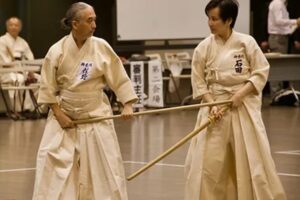The Art of the Short Staff
“杖道” is translated as “Jodo.” This term signifies the Way of the Short Staff, highlighting the art of wielding a staff or stick as a weapon in martial practice.
The Weapon

At the heart of Jodo and Jojutsu is the “jo,” a simple yet versatile weapon. This short staff, typically about four to five feet in length, becomes an extension of the martial artist’s body. The beauty lies in its simplicity, requiring skillful mastery for both offense and defense.
Origins
To truly appreciate Jodo and Jojutsu, one must journey into their historical roots. These martial arts have deep connections to Japanese warrior traditions, notably the samurai. The founder of Jodo, Muso Gonnosuke Katsuyoshi, is said to have developed the art after a defeat in combat, seeking a more versatile approach to staff fighting.
Techniques
1. Striking Techniques
Jodo and Jojutsu are renowned for their striking techniques. Practitioners learn a repertoire of strikes, thrusts, and sweeps, each executed with precision and fluidity. The goal is not just to deliver powerful blows but to seamlessly transition from one technique to another.
2. Defensive Maneuvers
Defense is an art in itself. The jo becomes a shield against attacks, with practitioners deflecting strikes and parrying with finesse. Footwork is crucial, as it allows martial artists to evade attacks and maintain a strategic position.
3. Kata
Kata, the choreographed sequences of movements, play a vital role in Jodo and Jojutsu. These sequences are a manifestation of combat scenarios, providing a structured platform for practitioners to refine their techniques and understand the flow of battle.
Philosophy
1. Mind and Body Unity
Central to Jodo and Jojutsu is the concept of “sou-shin,” the unity of mind and body. Practitioners strive not only to perfect physical techniques but also to cultivate mental focus and discipline. The jo becomes a conduit for this unity, reflecting the martial artist’s state of being.
2. Adaptability and Flow
Unlike rigid approaches, Jodo and Jojutsu emphasize adaptability. The fluidity of movements allows practitioners to adapt to varying situations seamlessly. It’s not just about mastering set techniques but embracing the flow of combat with creativity and responsiveness.
Modern Practice
In the modern era, Jodo and Jojutsu continue to thrive, with dedicated dojos and practitioners worldwide. While the essence remains rooted in tradition, there’s an acknowledgment of the need to adapt to contemporary contexts. Training methods, teaching approaches, and even the jo itself may see modifications, but the core principles endure.
A Personal Journey
As one delves into the world of Jodo and Jojutsu, it becomes a personal journey of self-discovery and growth. The jo, once a mere piece of wood, transforms into a companion on the path of martial mastery. It’s not just about combat; it’s an approach to life, blending physical prowess with mental resilience.
Concluding remark
Jodo and Jojutsu, centering around the use of the short staff, resonate across generations as a demonstration of the enduring quest for martial prowess. Beyond the specific techniques, there exists a philosophy that transcends the confines of the training space, shaping how practitioners navigate life’s intricate challenges. In the hands of a proficient artist, the jo transcends its role as a mere weapon; it embodies values of discipline, adaptability, and an unwavering commitment to mastery.
Thanks for taking the time to read this article.
Gert
